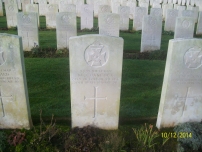| First Name: | Matthew James | Last Name: | HANCOCK | |
|---|---|---|---|---|
| Date of Death: | 30/04/1916 | Lived/Born In: | Highbury | |
| Rank: | Rifleman | Unit: | London6 | |
| Memorial Site: | ||||
Current Information:
Age-28 Enlisted-Holloway Cabaret-Rouge British Cemetery, Souchez, France
Imagine being in trench knowing that somewhere beneath your feet there is a mine, full of explosives and likely to go up at any moment. You know that there is little chance of escape. Trenches disappear. So do the men in them. Atomised into a thousand pieces and sent flying into the atmosphere or simply buried beneath tons of earth and debris. Left behind is a crater, the size of which depends on how much explosive has been used and how deep the mine had been dug, but is usually of a truly enormous depth and width. The waiting could and did send men mad. This is what faced men of 6th London Regiment of 140 Brigade, 47th Division who were occupying front line trenches on the northern part of the Vimy Ridge on 30th April 1916. “C” Company had moved up to these trenches on 26th April in support of the 19th London Battalion. No sooner had they arrived than the Germans blew a mine under the front line which formed a crater, 40 feet wide. But luckily, the front line was only thinly manned and casualties were few. As a matter of priority the crater was immediately seized and consolidated thus preventing the Germans from gaining a foothold in the British front line. That night the rest of 6th London moved up to the front line and the next day was spent strengthening their defences and trying to reconstruct the obliterated trench. The crater that now straddled their line was called New Cut Crater and it received special attention from the Germans who pounded it with shells, trench mortars and rifle grenades knowing full well that British troops would be busy preparing its defences. This continued for the next two days. And all the time the German mining operations continued. British miners could hear them at work and they were perilously close to the British front trenches. During the night of the 28th and 29th of April, British tunnelling companies exploded a small ‘camouflet’ charge close to a German mine and succeeded in blowing it up. This explosion formed a new crater which was named Broadridge Crater and once more defences had to be repaired urgently. Then the 30th April arrived and things got really hot. German activity increased and it was not a matter of ‘if’ the Germans exploded more mines, but rather of ‘when’. It was also very evident that the enemy were preparing an infantry attack so, only lightly manning the front trenches was no longer an option. That would simply hand it over to the Germans. The men of the 6th London had to sweat it out. All day they waited, pounded by shells and mortars and with the prospect of instant oblivion always in their minds At 6.45pm the Germans made their move. They exploded two mines close together under the centre of the line held by the battalion and which at that time was manned by “B” Company. Over forty men were killed by that explosion and the subsequent ferocious German artillery bombardment. The platoon in the very front were all killed as soon as the mine exploded but the rest of the battalion defended their battered lines in such a determined and heroic fashion that the Germans were unable to make any headway. The front trench was no longer recognisable and there were four large craters to be defended. Men crawled to the front lip of the new crater to take up a firing line that would stop German encroachment. Shell holes between all the craters were also manned by riflemen whilst others threw bombs and threw strips of barbed wire into the craters to prevent the enemy from occupying them. Others worked on the destroyed trenches and by the morning not only had all German attacks been repulsed but the trenches had been repaired enough to once more form the main defence. During this ordeal 6th London suffered many casualties, one of whom was Matthew Hancock. |
||||
| « Back to Search Results | ||||
| If you think any of the information shown here is incorrect, Click Here to submit your amends and comments | ||||




